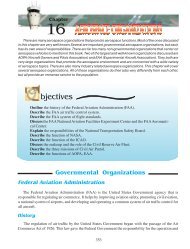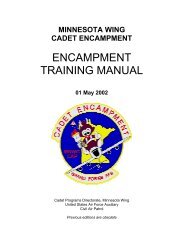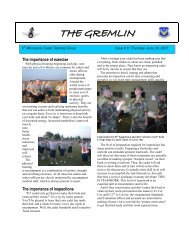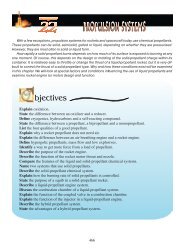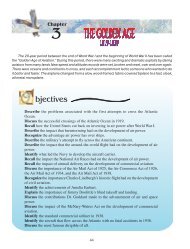D - 1 Fundamentals of Motivation and Motivational Techniques ...
D - 1 Fundamentals of Motivation and Motivational Techniques ...
D - 1 Fundamentals of Motivation and Motivational Techniques ...
You also want an ePaper? Increase the reach of your titles
YUMPU automatically turns print PDFs into web optimized ePapers that Google loves.
When you use punishment tools you must:- Let the soldiers know you are upset about the behavior <strong>and</strong> not about them.- Let the soldiers know you care about them as people but expect more from them as soldiers.- Do not punish soldiers who are unable to perform a task. Punish those unwilling or unmotivatedto succeed.- Never lose control <strong>of</strong> your temper.- Do not hold a grudge after punishment is over.c. Group rewards <strong>and</strong> punishments. While generally the same principles <strong>of</strong> reward <strong>and</strong> punishmentapply in both individual <strong>and</strong> group cases, the latter is vastly more complicated because <strong>of</strong> the greaternumber <strong>of</strong> personalities involved, <strong>and</strong> because <strong>of</strong> their interactions--many <strong>of</strong> which the leader may or maynot be aware. The basic problem is that group solutions not only apply to the group collectively, but to eachindividual in the group. It is <strong>of</strong>ten difficult for even the experienced leader to predict the important effects <strong>of</strong>rewards <strong>and</strong> punishments that are applied to the group. A group reward will be regarded differently by thevarious members. It is also unlikely that all group members performed or contributed equally hence, thesame reward may be differentially rewarding.Nevertheless, the group is a powerful influence <strong>of</strong> behavior. When the leader can inform the group inadvance about the adverse consequence <strong>of</strong> their undesirable behavior, they may exert the internal pressurenecessary to avoid the adversity <strong>and</strong> the results can be beneficial. When the consequence is reward orpunishment for individuals or subgroups within a larger body, the leader must be sensitive to the resultantperceptions <strong>of</strong> equity, fairness, <strong>and</strong> timeliness by group members who have performed as expected, as wellas those who did not. In this situation, the leader should also keep in mind that other organization memberswho were not involved in the performance may form their own perceptions <strong>of</strong> how the reward or punishmentact was carried out.Group rewards <strong>and</strong> punishments can be effective, especially when time is an issue. By using the groupapproaches, the leader must be willing to sacrifice the desirability <strong>and</strong> greater precision <strong>of</strong> the individualsolution.4. Recognizing <strong>and</strong> meeting soldier needs. All people have needs. Each <strong>of</strong> us needs food, water<strong>and</strong> shelter. Beyond these we need to feel secure in our home <strong>and</strong> work place. We need to belong to <strong>and</strong>be accepted by a group. We need to feel that we make a difference. Social scientists have developedseveral motivational theories based on the concept <strong>of</strong> needs. The underlying concept <strong>of</strong> all need theories <strong>of</strong>motivation is that an unsatisfied need creates a state <strong>of</strong> internal wanting or disequilibrium. In order torestore equilibrium, we are energized to reduce the need. In simple terms, a person will be motivated to dosomething which he or she perceives will satisfy a need or reduce the tension <strong>of</strong> an unpleasant situation.5. Serving as, <strong>and</strong> developing, positive role models. Role models within a unit can also be usedas motivators. You know that soldiers learn through observation <strong>and</strong> imitation. We also know that asoldier's level <strong>of</strong> commitment increases when he or she recognizes that the leaders are committed to theunit <strong>and</strong> its goals. Each member <strong>of</strong> your unit is a role model <strong>and</strong> as such has the potential to contribute toor detract from individual motivation. Positive role models can be:a. Formal leaders. Members <strong>of</strong> the formal chain <strong>of</strong> comm<strong>and</strong> are obviously role models. Theactions <strong>of</strong> the <strong>of</strong>ficers <strong>and</strong> noncommissioned <strong>of</strong>ficers (NCOs) <strong>and</strong> the consequences <strong>of</strong> those actions areobserved by the members <strong>of</strong> the unit. Leaders are constantly under the scrutiny <strong>of</strong> their subordinates.Officers <strong>and</strong> NCOs who demonstrate initiative, take responsibility for their actions, <strong>and</strong> develop well-trained,cohesive units, are positive role models. Soldiers will emulate their leaders <strong>and</strong> ultimately improve their ownperformance. When this occurs, role modeling is a positive motivator.b. Informal leaders. Within each organization, leaders who are not part <strong>of</strong> the chain <strong>of</strong> comm<strong>and</strong>emerge. An informal leader is an individual whom peers look to for direction. He or she is both trusted <strong>and</strong>respected. Because the informal leader exercises a great deal <strong>of</strong> control <strong>and</strong> influence within anD - 3
organization, it is essential that leaders identify the informal leaders as quickly as possible. Informalleaders can be used as an excellent role model for their peers. By tailoring your motivational tools to theinformal leader, you can influence the actions <strong>of</strong> the unit. However, you must be careful not to overlook thebeliefs <strong>and</strong> values <strong>of</strong> the other members <strong>of</strong> the unit. If informal leaders have a negative impact on themotivation <strong>of</strong> a unit, they must be dealt with quickly.c. Successful soldiers. Each soldier is a unique individual. Leaders who know their soldiers canincrease an individual's motivation by selecting tasks which are realistic yet challenging. A soldier'ssuccessful accomplishment <strong>of</strong> a task will be observed by others in the unit. Successful soldiers becomerole models for others who have not reached that level <strong>of</strong> achievement. An accurate underst<strong>and</strong>ing <strong>of</strong> yoursoldiers <strong>and</strong> their abilities is essential in developing successful soldiers.Successful soldiers who become informal leaders are excellent role models. They have earned the trust<strong>and</strong> respect <strong>of</strong> their fellow soldiers. Leaders influence the actions <strong>of</strong> their unit by developing informal leaderswho are positive role models. However, the leader must also be aware that an informal leader may also be apoor role model. If the informal leader models inappropriate behavior he/she negatively influences your unit<strong>and</strong> more importantly, your soldiers. When developing the informal leader, use caution. You don't want togive the impression that you're giving preferential treatment to a specific individual.SUMMARY. <strong>Motivation</strong> results in action. By serving as an ethical st<strong>and</strong>ard bearer, building cohesivesoldier teams, properly using rewards <strong>and</strong> punishments, recognizing <strong>and</strong> satisfying individual needs, <strong>and</strong> byserving as, <strong>and</strong> developing, positive role models, leaders motivate their subordinates to act in a way thathelps the unit.We have just presented actions which the leader can take to motivate subordinates. But how do youdecide which is the best action to take? Knowing actions you can take to improve motivation is important,but underst<strong>and</strong>ing the underlying motivation factors can help you to be an even more effective leader. Thereading above included a short discussion <strong>of</strong> Maslow’s Hierarchy <strong>of</strong> Needs <strong>and</strong> other theorists such asAlderfer <strong>and</strong> Herzberg (summaries below), <strong>and</strong> discussed motivation in terms <strong>of</strong> motivation being internal tothe individual or work environment. These theories are concerned with identifying what it is within anindividual or the work environment that energizes <strong>and</strong> sustains behavior. That is, what specific thingsmotivate people?D - 4
THEORIES OF MOTIVATIONSection I: Needs TheoriesNeeds theories <strong>of</strong> motivation assume that all people share a common set <strong>of</strong> basic needs--internal states<strong>of</strong> tension or discomfort that the individual is motivated to change. The needs theories <strong>of</strong> motivation areconsidered to be the most popular <strong>of</strong> the motivation theories.The underlying concept <strong>of</strong> all need approaches is that a need that is unsatisfied creates a state <strong>of</strong>internal disequilibrium which is uncomfortable for the individual. In order to restore equilibrium, the individualis “energized” to reduce the need. This approach assumes that human beings constantly seek a state <strong>of</strong>equilibrium. When thirsty, one drinks to reduce the feeling <strong>of</strong> thirst. When dissatisfied with a job, we dosomething to solve the problem. In motivation terms, the individual is motivated to engage in behaviors thatwill satisfy a need <strong>and</strong> reduce associated tension.A. MASLOW’S HIERARCHY OF NEEDSThe best known <strong>of</strong> the need theories <strong>of</strong> motivation is Abraham H. Maslow’s hierarchy <strong>of</strong> needs theory.Maslow’s theory is popular because <strong>of</strong> the optimistic picture <strong>of</strong> human nature that it presents. He originallyproposed his theory as a study <strong>of</strong> the ultimate human goals people seek. Maslow’s theory stresses twobasic premises:1. Human beings are constantly in a state <strong>of</strong> “wanting.” Needs which are not satisfied are motivators.Needs which have been satisfied can not be motivators. Humans rarely reach a state <strong>of</strong> completehomeostasis or satisfaction. As soon as one desire is gratified, another surfaces to take its place. Maslowbelieved that humans are always “wanting.”2. Human needs are arranged in order <strong>of</strong> importance. Once a need is satisfied, another takes its place.The needs range from fundamental animal needs (lower level) to the more advanced human needs thatrepresent the uniqueness <strong>of</strong> mankind (higher levels). They are represented in the chart below in ascendingorder. Those at the bottom <strong>of</strong> the drawing must be satisfied before the higher-level needs can be satisfied.a. Physiological needs are basic to the survival <strong>of</strong> the organism <strong>and</strong> include such things as food,water, rest, shelter, <strong>and</strong> air. The physiological needs will dominate when they are unsatisfied. As a result,no other need will serve as a basis for motivation until the physiological needs are met. For example,Maslow stated, “a person who is lacking food, safety, love <strong>and</strong> esteem probably would hunger for food morestrongly than for anything else.”b. Safety needs are concerned with providing a safe <strong>and</strong> secure environment, free from threats toone’s existence. Safety needs also include areas such as protection from ill health, economic disaster,physical harm <strong>and</strong> the unexpected. Safety needs may be manifested in the subordinate’s concern with jobsecurity <strong>and</strong> benefits.3. Social needs deal with the need for friendship, affection, <strong>and</strong> affiliation, <strong>and</strong> are sometimes referredto as belongingness or need for love. It is at this point that the needs separate from the physical or quasiphysicalneeds <strong>and</strong> where failure to satisfy the needs at this level can affect the individual’s mental health.4. Esteem needs are concerned with the desire <strong>of</strong> individuals to have a stable, high evaluation <strong>of</strong>themselves <strong>and</strong> to have respect from other people. Satisfaction <strong>of</strong> these needs leads to a feeling <strong>of</strong> selfconfidence<strong>and</strong> prestige.5. Self-actualization needs refer to the desire to achieve self-fulfillment, to develop one’spotential to the fullest, to become everything that one is capable <strong>of</strong> becoming, <strong>and</strong> to achieve fulfillment <strong>of</strong>one’s life goals.D - 5
Higher Order Needs`SelfActualizationEsteem NeedsLower Order NeedsSocial NeedsSafety NeedsPhysiological NeedsMaslow’s Five Levels <strong>of</strong> NeedsMaslow argues that needs are arranged in a hierarchy <strong>of</strong> importance in which each lower level needmust be fulfilled to some degree <strong>of</strong> satisfaction before advancing to the next higher level need. Hence wesee that Maslow considers a lower level need as being the most potent motivator when it is not satisfied.On the other h<strong>and</strong>, Maslow does not propose that a lower level need must be completely satisfied before thenext higher level need becomes important. In fact, Maslow said that “...most members <strong>of</strong> our society whoare normal are partially satisfied in all their basic needs...”Maslow uses the concepts <strong>of</strong> deprivation <strong>and</strong> satisfaction to change his theory from one that merelycategorizes needs to one that tells how needs affect behavior. The deprivation/ satisfaction process dealswith the way in which needs are activated by the external environment to produce need-fulfilling behaviors.The deprivation concept is used to explain the temporary dominance <strong>of</strong> a particular need level over others.Maslow’s position is that environmental deprivation <strong>of</strong> lower level needs would lead to a domination <strong>of</strong> thatneed level in the person’s day-to-day activities. For example, those who have been on a restricted diet knowthe craving that follows notification that certain foods are now banned. The longer we go without satisfyingthat need, the more it dominates every sensory attention. We may even notice pictures <strong>of</strong> the restrictedfoods where we have never noticed them before. After that dominant need is finally satisfied, however, we nolonger pay particular attention to that food--another need is activated. So we have a continuous processwhere each need level in turn becomes satisfied, <strong>and</strong> the next need level becomes dominant until all lowerlevel needs have been satisfied <strong>and</strong> we become primarily concerned with the need for self-actualization.Maslow referred to lower order needs as “deficiency needs” <strong>and</strong> to higher order needs as “growthneeds.” The deficiency needs consist <strong>of</strong> physiological, safety, <strong>and</strong> social (love/belongingness) needs. Thegrowth needs are esteem <strong>and</strong> self-actualization. The distinction between the deficiency needs <strong>and</strong> thegrowth needs is key to Maslow’s theory. Deficiency needs motivate behavior only if they are in a state <strong>of</strong>deprivation. In other words, the less you have, the more you want, <strong>and</strong> the more you will do for it. However,once a deficiency need is satisfied, it loses its motivating force. People will go to great lengths to satisfythirst, but, once satisfied, water will probably not motivate behavior any longer (at least notimmediately). Growth needs, on the other h<strong>and</strong>, are those that continue to motivate behavior even whenwhatever it is that satisfies the need is being received. For growth needs, the more you get, the more youwant, <strong>and</strong> the more you will do for it! Receiving recognition <strong>and</strong> praise from others usually increases themotivational force <strong>of</strong> esteem needs.D - 6
D - 7
B. ALDERFER’S THEORY: EXISTENCE, RELATEDNESS, AND GROWTHResearch based on Maslow’s concept <strong>of</strong> needs demonstrated some problems with his hierarchy <strong>of</strong>needs theory. Although findings appeared consistent in the very low levels <strong>and</strong> at high levels, conflictingfindings were reported in the areas <strong>of</strong> social, safety, <strong>and</strong> esteem. Primarily, there appeared to be a greatdeal <strong>of</strong> overlap in these three levels. For this reason, Clayton P. Alderfer, another need theorist, modifiedMaslow’s approach <strong>and</strong> developed what he calls Existence, Relatedness, <strong>and</strong> Growth (ERG) theory. Themajor differences between the Maslow <strong>and</strong> Alderfer approaches center around three concepts: how needsare categorized , the relationship <strong>of</strong> needs <strong>and</strong> levels, <strong>and</strong> what happens when a need is not satisfied.To clear up the overlaps in Maslow’s hierarchy, Alderfer rearranged Maslow’s five levels into threecategories shown in the figure below. Alderfer proposed that security, social, <strong>and</strong> esteem (from others) area common type <strong>of</strong> need as they all involve some interpersonal relationship. He therefore combined theseinto a single class <strong>of</strong> needs called “relatedness needs.” Self-esteem is based on internal cues <strong>of</strong> personalachievement, independence, <strong>and</strong> goal achievement, <strong>and</strong> thus appears very close to self-actualization.These two needs are combined into “growth needs” in ERG theory. Finally, those safety needs, which arerelated to physical (as opposed to interpersonal) security, could be seen as strongly akin to physiologicalneeds. These two levels he combined into “existence needs.”The second concept addressed differently in the two theories is the relationship between needs <strong>and</strong>levels. Recall that Maslow suggests a strict hierarchy--all lower needs must be minimally satisfied before ahigher need can be operative. ERG theory, although hierarchical, does not presuppose a strict hierarchy.Thus, in ERG theory, it is not contradictory that a person will deny himself basic needs in order to becreative or to gain the esteem <strong>of</strong> others. Consider, for example, the inconsistency that the hunger strikerposes for a strict hierarchical approach.The final difference concerns the relationship <strong>of</strong> needs <strong>and</strong> dissatisfaction. Although Maslow <strong>and</strong>Alderfer would agree that satisfaction at each need level leads to desire at the next higher one, they see adifference in what happens to unsatisfied needs. In Maslow’s theory, an unsatisfied need providesmotivation. For example, to the extent that all lower level needs are satisfied <strong>and</strong> self-actualization is not,people will be motivated to self-actualize. ERG theory provides a more complex view <strong>of</strong> this relationship. Tothe extent that a need is not satisfied, it provides motivation. However, if the drive for that need is frustrated,people may compensate by substituting fulfillment at the next lower need level. Thus, to the extent thatgrowth needs are desired <strong>and</strong> not satisfied, people may turn to relatedness needs as an alternative. Also,to the extent that relatedness needs are unsatisfied, people will continue to seek relatedness, but may alsoincrease their desire for existence needs. Thus, according to Alderfer, an unsatisfied need does notnecessarily motivate only at that level, but may also be compensated for at a lower level.D - 8
This distinction is particularly important because the leader may compensate a subordinate byconcentrating on relatedness needs when growth needs cannot be met on the job. For instance,sometimes organizations emphasize the “family” aspect <strong>of</strong> the organization or use slogans such as “Wetake care <strong>of</strong> our own” as compensation for the lack <strong>of</strong> challenging jobs. This, in effect, emphasizes thefulfillment <strong>of</strong> the need to feel wanted or secure to make up for the deficiency in a feeling <strong>of</strong> accomplishmentor achievement.SELF-ACTUALIZATIONGROWTHESTEEM (SELF)ESTEEM (OTHERS)SOCIALRELATEDNESSSAFETYSECURITYEXISTENCEPHYSIOLOGICALMASLOWALDERFERComparison <strong>of</strong> Maslow <strong>and</strong> Alderfer’s Need CategoriesD - 9
D - 10
C. HERZBERG’S TWO-FACTOR THEORY:Herzberg’s work centered on the job or work itself <strong>and</strong> what can be done with it to enhance individualmotivation. Basically Herzberg’s work looks at such issues surrounding restructuring a job to increasesubordinate performance. His studies deal with factors which are job satisfiers <strong>and</strong> how they differ fromfactors which result in dissatisfaction. His work lead him to draw two main categories <strong>of</strong> factors:1. Maintenance factors. There are factors/conditions which serve primarily as dissatisfiers to workerswhen they are not present. Herzberg called these factors the Maintenance Factors. The presence <strong>of</strong>Maintenance Factors does not result in strong motivation. Rather, it is the absence <strong>of</strong> these factors whichleads to dissatisfaction. In other words, the factors are more potent as dissatisfiers when they are absentthan they are as motivators when they are present. Some <strong>of</strong> these factors include:Policy <strong>and</strong> administrationTechnical supervisionInterpersonal relations with supervisor, peers<strong>and</strong> subordinatesStatusSalaryJob securityPersonal lifeWork conditions2. <strong>Motivation</strong>al factors. Herzberg also identified a second set <strong>of</strong> factors that lead to high levels <strong>of</strong>motivation <strong>and</strong> job satisfaction when they are present, but which do not prove to be highly dissatisfying ifthey are absent. Herzberg named these factors <strong>Motivation</strong>al Factors. The following factors are amongthose he identified as <strong>Motivation</strong>al Factors:AchievementAdvancementRecognitionThe work itselfPossibility <strong>of</strong> personal growthResponsibilityThus, Herzberg found that the opposite <strong>of</strong> job “satisfaction” is not “dissatisfaction” but “nosatisfaction.”A comparison <strong>of</strong> Herzberg’s two factors is presented below:FACTOR TYPE ABSENCE OF FACTOR PRESENCE OF FACTORMaintenance Factors Dissatisfaction No dissatisfaction<strong>Motivation</strong>al Factors No satisfaction SatisfactionHerzberg’s work has led to interest in job enrichment that attempts to restructure the job toincrease the worker’s job satisfaction. Herzberg ‘s theory implies that if leaders focus on MaintenanceFactors, motivation will not occur. <strong>Motivation</strong> must be built into the job itself in order to improve motivation.D - 11
Below is a comparison <strong>of</strong> the three motivational theories about which you read: Maslow, Alderfer, <strong>and</strong>Herzberg. Similarities <strong>and</strong> differences between the three theories can easily be seen.Self-ActualizationGrowthSelf Esteem (Self)Self-Esteem (Others)<strong>Motivation</strong>al FactorsRelatedness SocialMaintenance FactorsSecuritySafetyExistencePsychologicalALDERFER MASLOW HERZBERGCOMPARISON OF ALDERFER, MASLOW AND HERZBERG’S THEORIESD - 12
Section II: Process TheoriesOther theories <strong>of</strong> motivation try to explain <strong>and</strong> describe the process <strong>of</strong> how behavior is energized,directed, sustained, <strong>and</strong> finally stopped. Some <strong>of</strong> the theories <strong>of</strong> this type we are going to cover include thefollowing approaches: Equity Theory, Expectancy Theory, Goal Setting <strong>and</strong> Job Redesign. These theoriesprovide you with ways that you can look at your work environment <strong>and</strong> make appropriate behavioral <strong>and</strong>organizational changes which may result in increased motivation on part <strong>of</strong> your subordinates. Thesetheories first attempt to define the major variables necessary for explaining choice (e.g., should I work hard),effort (e.g., how much do I need to work), <strong>and</strong> persistence (e.g., how long do I have to keep this pace).A. EQUITY THEORYHave you ever been in a situation where, after you worked hard to obtain a reward, you were dissatisfiedwith the reward you received? Perhaps the reward was one that was <strong>of</strong>fered to other people also. Was itreceived by someone you didn’t think devoted as much effort to earning it as you did? Perhaps your sense<strong>of</strong> fairness was violated. Humans have a culturally induced belief that life owes them a "fair shake." Thisdesire for equity is based on the belief that there should be an equitable distribution <strong>of</strong> rewards based oncontributions. What we get out <strong>of</strong> our work should reflect what we put into it. Equity theory states that wejudge the equity <strong>of</strong> our outcomes by a process <strong>of</strong> comparison. We generally believe that there should be anequitable distribution <strong>of</strong> rewards based on an individual’s input.Equity theory removes needs from their social isolation <strong>and</strong> makes the assumption that peopleengage in social comparison <strong>and</strong> are attentive to the process <strong>of</strong> exchanging their work contributions fororganizational rewards. Either the exchange is perceived as equitable, or some adjustment will have to bemade. As with need theories (Maslow is an example), equity theory assumes that a feeling <strong>of</strong> inequity willresult in tension within the individual, <strong>and</strong> that the individual will be motivated to reduce that tension. Thebehaviors associated with this tension reduction provide the key for a motivational strategy for leaders.The clear implication <strong>of</strong> equity theory for leaders is that they must insure that there is a perception<strong>of</strong> fairness associated with the organizational rewards system. If this sense <strong>of</strong> fairness does not exist, theleader must take steps to establish it in the minds <strong>of</strong> the subordinates as well as within the objective reality<strong>of</strong> the rewards system. (It is important to remember that the way people perceive things is more importantto subsequent behavior than is the objective reality--the way things actually are.)Equity theory involves the inputs a person brings to the work environment <strong>and</strong> the outcomes theperson receives as a result <strong>of</strong> those inputs. It is the ratio <strong>of</strong> these inputs to outcomes in comparison withthe perception <strong>of</strong> this ratio for other persons which is <strong>of</strong> importance to the leader. People normally comparethemselves with others whom they see as being like themselves in terms <strong>of</strong> either similar past experience orsimilar interests. For example, the “A” student probably compares himself/herself with other “A” students.The comparison person usually is not the same in all situations. For example, we do not use the samecomparison person in academic, sports, <strong>and</strong> work situations. Also, the comparison person may be acomposite, or ideal, rather than an actual person.The notation used to describe the comparison ratio is:Own Outcomes compared withOwn InputsOther’s OutcomesOther’s InputsSuppose you work hard <strong>and</strong> the organization promotes you ahead <strong>of</strong> schedule, while peers fail towork hard <strong>and</strong> are not promoted early. The notation would be as follows:D - 13
Individual OthersHigh Outcome (Early promotion) compared with Low Outcome (No early promotion)High Input (Work Hard)Low Input (Not working hard)Based on the ratios above, you would probably conclude that this is an equitable situation wherehard work resulted in your early promotion while your peers, who did not work hard, did not receive a reward.If however, the situation presented by the following set <strong>of</strong> ratios occurred, you might not feel the same way:OwnOthersHigh Outcomes compared with High OutcomesHigh InputsLow InputsIn the second example, where peers receive the same outcome without contributing the samedegree <strong>of</strong> inputs, you would probably find inequity existing <strong>and</strong> would probably be disturbed <strong>and</strong> frustrated.As you can conclude, inequity has two aspects. First, people feel underrewarded when they receive feweroutcomes than they think they deserve. Second, people feel overrewarded when they receive more inoutcomes than they feel they deserve. Thus, the three conditions which can result under equity theory areequity, under-reward, <strong>and</strong> over-reward.How does the equity theory relate to motivation? As long as a feeling <strong>of</strong> equity exists, individualswill continue to operate as they have been doing. A feeling <strong>of</strong> over reward usually is not a problem for theindividual. However, if the individual feels under rewarded, you have a motivation problem. Additionally, thetheory suggests that the strength <strong>of</strong> the motivational force is directly proportional to the degree <strong>of</strong> inequity.Equity Restoration StrategiesA person experiencing inequity uses one <strong>of</strong> six equity restoration strategies to return to a state <strong>of</strong>equity.1. The individual may alter inputs. The most direct motivational strategy is for the individual to changetheir job input--to do more or less work--thereby restoring perceived equity. If, for instance, the imbalance isthe direction <strong>of</strong> underreward, reduction <strong>of</strong> input is a common strategy. When people feel overrewarded,however, they tend to restore equity by means other than increasing input. People are reluctant to changeinputs which are directly related to self-esteem--few people, for instance, will de-value themselves to gainmore organizational rewards. For the leader, this means that providing more rewards may not increaseperformance (input), but that providing too few may reduce it.2. The individual may alter outcomes. Usually this involves trying to get more for what is being done,rather than trying to get less for doing too little. People will try to maximize outcomes that are important tothem as well as resist changing outcomes which threaten self-esteem. Sometimes they may even resort tounethical efforts to restore equity. For the leader, this reinforces the need to be sensitive to perceivedinequity, <strong>and</strong> to increase rewards when appropriate.3. The individual may cognitively distort inputs <strong>and</strong> outcomes. Although it is difficult to distort objectivereality, people can <strong>and</strong> will distort the impact <strong>of</strong> different aspects <strong>of</strong> the real situation to resolve inequity. Tosay to oneself, “That wasn’t very important anyway,” is one way to distort an outcome which you haveworked for but failed to receive. Again, cognitive changes that threaten self-esteem will be resisted. Also, itis <strong>of</strong>ten easier to distort one’s perception <strong>of</strong> someone else’s inputs or outcomes than our own. TheD - 14
individual may say, for example, “We may be getting the same pay, but the boss thinks more highly <strong>of</strong> methan <strong>of</strong> him because I work harder.”4. The individual may act on the comparison other. Simply, the individual may try to get thecomparison other to change either inputs or outcomes. We observe this happening with informal norms thatrestrict production, or in situations where pressure is placed on a group member to decrease work inputs.Comments such as, “What are you trying to do, make the rest <strong>of</strong> us look bad?” are powerful demotivatorswhich seek to restore equity.5. The individual may change the comparison other. If people cannot resolve the inequity betweenthemselves <strong>and</strong> a reference other, they may simply change the reference point. People who have acomparison other that they have been using for a long time, however, normally find it difficult to change theobject <strong>of</strong> comparison.6. The individual may leave the field. Quitting is a realistic escape from a situation <strong>of</strong> inequity, <strong>and</strong>absenteeism <strong>and</strong> turnover are prime indicators <strong>of</strong> perceived inequity. For people who have been with theorganization for a long time, quitting is usually a last-resort strategy.Equity theory predicts that one or more <strong>of</strong> the six steps discussed above will be taken as aninequity resolution strategy by subordinates in organizations. Note that the only strategies with a directeffect upon behavior changes are the alterations <strong>of</strong> one’s own inputs <strong>and</strong> quitting. All <strong>of</strong> the other strategiesmay affect behavior indirectly, but generally restrict themselves to attitude changes or attempts to changeenvironment rather than performance. The most appropriate place for the leader to intervene, then, is whereinequity affects behavior. It is important for the leader to underst<strong>and</strong> the vital role <strong>of</strong> perception in motivation.A person’s expectancies, depend upon a person’s perceptions. The importance <strong>of</strong> perceptual differencesamong workers with similar skill levels is made obvious by the expectancy theory. Different levels <strong>of</strong>motivation among people with similar skills could be explained in terms <strong>of</strong> perceptual differences.The major observation for the leader here is that several <strong>of</strong> the resolution strategies are potentiallyadverse for the organization. Therefore, the lesson <strong>of</strong> equity theory for the organizational leader is prevention<strong>of</strong> perceived <strong>and</strong> actual inequity. The major underlying premise <strong>of</strong> equity theory is that the wholecomparison process is based on the perceived situation, which may or may not reflect reality. The leadermust be alert to perceived inputs by subordinates, as well as to the fairness <strong>of</strong> the outcomes provided forthose inputs. A knowledge <strong>of</strong> equity theory puts pressure on the leader to discriminate in allocating rewardsbased on performance. Further, perceptions <strong>of</strong> inequity dem<strong>and</strong> that the leader insure that the objectivereality <strong>of</strong> organizational reward systems is clear to all subordinates. Leaders should be able to analyze thereward system from a subordinate’s viewpoint. In conclusion, equity theory tells us that organizationalrewards must depend on level <strong>of</strong> performance so that there is perceived equity (not necessarily equality).D - 15
B. EXPECTANCY THEORYThe anticipation <strong>of</strong> a reward or punishment also motivates people. This is called expectancy theory.When a person expects an important reward, there is an increase in the intensity <strong>and</strong> persistence <strong>of</strong>behavior directed toward that reward. The expectancy <strong>of</strong> a reward motivates behavior. The expectancytheory is based on four assumptions:1. Behavior is caused by a number <strong>of</strong> forces in the work environment <strong>and</strong> in the individual.2. People consciously make decisions about their behavior.3. People have different types <strong>of</strong> needs, goals, <strong>and</strong> desires.4. People will do things which will result in favorable outcomes <strong>and</strong> will avoid those behaviors whichlead to unfavorable outcomes.A person who expects or anticipates a valued reward will work hard to achieve the level <strong>of</strong> performancenecessary to receive the reward. However, performance is not simply working hard. In addition to effort, theperformance level <strong>of</strong> an individual is limited by innate skills <strong>and</strong> abilities. If this is the case, no matter howmotivated the subordinate is, it is unlikely that performance will exceed a certain ability level. Therefore, aleader’s motivation strategy must include an assessment <strong>of</strong> the skills <strong>and</strong> abilities <strong>of</strong> subordinates. A thirdvariable that must be considered by the leader is the knowledge on the part <strong>of</strong> the subordinate <strong>of</strong> those jobrelatedbehaviors which lead to a desired performance level. This is different from ability. Such behaviorsmay include some work behaviors that the boss desires even though the subordinate may not see therelation between these <strong>and</strong> objective performance outcomes. People may learn “what to do” through priorlearning in similar circumstances, through communication with more experienced workers, <strong>and</strong> throughexperience on the job. They usually learn “how to do” from the boss. That is, they learn how the bosswants the job performed. So, performance in work settings is a function <strong>of</strong> three interrelated variables:subordinate skills, abilities, <strong>and</strong> personality; subordinate effort; <strong>and</strong> accuracy <strong>of</strong> subordinate perception <strong>of</strong>how the boss wants the job done.The expectancy theory is a complex motivational theory. However, it is an important theory as itprovides a great deal <strong>of</strong> insight into why some attempts to motivate soldiers are successful <strong>and</strong> others fail.In order to better underst<strong>and</strong> the theory, let's build a model <strong>of</strong> the theory.Individual Behavior Performance Outcomes Reward OutcomesExpectancy Theory ModelIndividual behaviors are the actions a person performs. Performance outcomes are the results <strong>of</strong> theindividual's behavior or action. Some <strong>of</strong> these outcomes are desirable for the unit, others are not. Use thefollowing example to clarify the model.Example: Everyone has to take the PT test twice a year. If we practice the three events regularly(individual behaviors), the practice should result in a higher number <strong>of</strong> repetitions <strong>and</strong> faster time onthe two-mile run (performance outcomes). The high number <strong>of</strong> repetitions <strong>and</strong> faster time, however,are valuable to us only because <strong>of</strong> the reward outcomes associated with them which is pass the PTtest or, in many cases, max the PT test.Reward outcomes are either intrinsic or extrinsic. The satisfaction <strong>and</strong> sense <strong>of</strong> achievement from beingphysically fit may be reward enough. This is an intrinsic reward because the behavior is important in <strong>and</strong> <strong>of</strong>itself. If, on the other h<strong>and</strong>, the soldier strives to obtain a high score on the PT test just to earn the respectD - 16
<strong>of</strong> his peers or superiors, the reward is extrinsic. The reward is not tied to the behavior but rather to theassociated needs. Intrinsic rewards are controlled by the individual. Extrinsic rewards are generallycontrolled by others.Unfortunately, not all soldiers are intrinsically motivated to accomplish their assigned tasks <strong>and</strong>responsibilities. Leaders who underst<strong>and</strong> what motivates their soldiers can use expectancy theory toimprove individual <strong>and</strong> unit performance. Let's take a more detailed look at our model.How can the leader view the expectancy theory in terms <strong>of</strong> value to the organization? We have threesets <strong>of</strong> variables displayed in the model: individual behaviors, performance outcomes, <strong>and</strong> reward outcomes.The relationship between the individual's behavior <strong>and</strong> the performance outcome is the expectancy or thebelief that a given behavior will result in the desired performance outcome. This belief is subjectiveExample: The belief is that by practicing push-ups or sit-ups, you will achieve the performanceoutcome (a high number <strong>of</strong> repetitions on the PT test) is the expectancy.Leaders affect the expectancy or belief by teaching the subordinate behaviors that lead to theperformance outcome. If the subordinates really believe that the behaviors they learn or do lead to theperformance outcome, there is a high degree <strong>of</strong> expectancy.Example: Let's look at our PT test example. A platoon leader starts a PT test training programwith the goal <strong>of</strong> having everyone in the platoon achieve a minimum <strong>of</strong> 60 push-ups, 60 sit-ups <strong>and</strong>running 2 miles in 15 minutes. The behaviors are training in preparation for the PT test. Theperformance outcomes <strong>of</strong> obtaining 60, 60 <strong>and</strong> a 15-minute two-mile time would have a highexpectancy for most soldiers since most <strong>of</strong> the soldiers probably believe that, with practice, theycan obtain these goals.There is also a relationship between the performance outcome <strong>and</strong> the reward outcome. If thesubordinate knows that by achieving the desired level <strong>of</strong> performance, valued reward outcomes follow, wecan say that the act <strong>of</strong> achieving the performance outcome is instrumental in obtaining the rewardoutcomes. We call this relationship the instrumentality relationship. You'll notice that the instrumentality isa relationship between two outcomes--performance <strong>and</strong> reward. Leaders exercise the greatest degree <strong>of</strong>control over these two outcomes. First, they are generally the ones who set the performance st<strong>and</strong>ard.Second, they generally have full control over the reward for achieving the desired level <strong>of</strong> performance. Inorder to motivate soldiers, the soldiers must be reasonably certain that the reward will be provided by theleader. If the leader's track record <strong>of</strong> providing rewards is good-there will be a high instrumentality level. Ifthe leader's track record is poor-the instrumentality level is low <strong>and</strong> the subordinate is less likely to achievethe performance outcome. In short, the instrumentality is dependent upon the leader's ability to ensure thepromised rewards are available from the organization.Example: Our platoon leader wants to reward all those soldiers who achieve his goal <strong>of</strong> 60, 60 <strong>and</strong> 15minutes. He/she decides to make PT optional for those who achieve his/her goal. Since the PT testtraining sessions are the idea <strong>of</strong> the platoon leader <strong>and</strong> he/she runs the sessions, then theinstrumentality <strong>of</strong> this reward would be high. The soldiers can expect to achieve this reward if theyobtain the leader’s PT goals. If the PT test training program is a company level program <strong>and</strong> the platoonleader promised the same reward while the company comm<strong>and</strong>er announces something different, thenthe instrumentality <strong>of</strong> the platoon leader's reward would be low.The final aspect <strong>of</strong> the basic expectancy theory addresses the importance <strong>of</strong> each outcome. The termgiven to the importance that the subordinates place on each outcome is called valence.In our example, the reward <strong>of</strong> being exempt from the PT sessions may have a high valence if the PTsessions are held under unpleasant conditions or after duty hours. Also, if being recognized as an individualexcused from PT gives soldiers additional status or recognition from other soldiers, that may contribute to aD - 17
positive valence <strong>of</strong> the reward outcome. If, however, the soldiers who are excused from PT catch a lot <strong>of</strong>flack from other soldiers, that reward outcome may have a negative valence. This would also be true ifattending the PT sessions is viewed by the soldiers as a fun, team building activity. In both <strong>of</strong> these cases,the valence <strong>of</strong> the reward outcome would negate the purpose <strong>of</strong> the reward. The important point is that theleader must carefully determine the valence <strong>of</strong> the reward outcome before linking the performance outcometo the reward outcome.The brief summary below presents an illustrative list <strong>of</strong> leader actions available to the organizationalleader to increase a subordinate’s expectancy, instrumentality <strong>and</strong>/or valence:D - 18
1. To increase expectancy (Can I achieve the desired level <strong>of</strong> task performance?):a. Clarify the relationship between individual behavior <strong>and</strong> performance outcomes. Show thesubordinate what specific behavior will lead to the desired performance outcome.b. Lower the performance outcome/st<strong>and</strong>ard, if consistent with organizational goals.c. Conduct additional training for the subordinate.d. Alter the subordinate’s perception <strong>of</strong> his/her capabilities, (i.e., build the subordinate’s selfconfidence).e. Restructure the work environment (resource availability, etc.).2. To increase instrumentality (What is the probability that rewards will be received as a result <strong>of</strong> theperformance?):a. Ensure that a well-defined performance outcome to reward outcome relationship is established,effectively communicated, <strong>and</strong> understood by all. Make the reward contingent on the desired performanceoutcome.b. Ensure that equitable rewards are available, contingent on performance, <strong>and</strong> consistentlyadministered in a timely manner.3. To increase valence (How highly do I value the reward outcomes?):a. Determine what reward outcomes are valued (via surveys, direct observations, direct inquiries, needtheories, etc.) <strong>and</strong> provide those outcomes.b. Clarify individual perceptions concerning the value <strong>of</strong> reaching particular performance outcome. Theindividual may be overlooking some critical reward outcomes that are associated with the performanceoutcome in question.How can you use this theory? You, the leader, can motivate soldiers by influencing the expectancy, theinstrumentality, <strong>and</strong> the valence. You can make the expectancy high by making the desired performanceoutcomes challenging but achievable. You can make the instrumentality high by promising only the rewardsthat you can provide <strong>and</strong> by following through with the rewards you promise. Finally, you can make surethat the awards are desirable. High expectancy, high instrumentality <strong>and</strong> high valence help motivatesoldiers to perform at a high level.D - 19
C. GOAL SETTING THEORYGoal setting also affects motivation. Simply stated, goal setting is a process where leaders <strong>and</strong> theirsubordinates jointly identify common objectives, define subordinates’ major areas <strong>of</strong> responsibility in terms<strong>of</strong> the results expected, through mutual agreement obtain the subordinates’ personal commitment, <strong>and</strong> usethese objectives as guides for operating the unit <strong>and</strong> assessing the contribution <strong>of</strong> each <strong>of</strong> its members.This is one approach to motivation--establishing clear goals <strong>and</strong> objectives. The subordinates want to workbecause they thoroughly underst<strong>and</strong> what is expected <strong>of</strong> them <strong>and</strong> what they need to accomplish. Thesubordinates feel a sense <strong>of</strong> ownership in the organization's goals. Goal setting is the theory behind thecurrent <strong>of</strong>ficer evaluation report support form.The positive side <strong>of</strong> goal setting is that it places the leader's emphasis on results rather than h<strong>and</strong>lingdaily crises. Teamwork is improved because <strong>of</strong> more clearly defined goals, established priorities <strong>and</strong>planned resource allocation. Goal setting provides for the possibility <strong>of</strong> clear st<strong>and</strong>ards for performanceevaluation <strong>and</strong> creates an environment for constructive <strong>and</strong> timely criticism, better communications <strong>and</strong>greater subordinate development. Since subordinates know what is expected <strong>of</strong> them, know whatconstitutes success, <strong>and</strong> agree to the objectives, they are motivated to accomplish their jobs.The leader must be careful that the goal setting process fits the needs <strong>and</strong> realities <strong>of</strong> the organization.Some leaders feel threatened by goal setting because they believe they lose control <strong>and</strong> authority whensubordinates are allowed to help in setting goals <strong>and</strong> action plans. The leader must ensure the goals areachievable by subordinates but still challenging. Leaders must be careful not to place too much emphasison numerically measurable results. This creates a climate <strong>of</strong> leadership by statistics <strong>and</strong> involves anextraordinary amount <strong>of</strong> paperwork. If used well, the positive aspects <strong>of</strong> goal setting outweigh thelimitations. The periodic review <strong>of</strong> the progress achieved by the leader <strong>and</strong> subordinate greatly assists in thedevelopment <strong>of</strong> subordinates, improves communication, increases individual motivation <strong>and</strong> improves theorganization's planning capability.How can you use this theory? Research indicates that goals which are both specific <strong>and</strong> difficult resultin consistently higher effort <strong>and</strong> performance than when the established goal focuses on “do your best” typegoals. Secondly, goal commitment is critical. Even though subordinate participation in developing the goalsis one way to increase commitment, goals set by the leader or jointly between the leader <strong>and</strong> subordinatescan both result in the accomplishment <strong>of</strong> the desired goal. Subordinates were as committed to goalsassigned to them as they were to the goals they helped establish when they viewed the leader as having thelegitimate authority, having confidence in the subordinates <strong>and</strong> having clear st<strong>and</strong>ards for the performance.Regardless <strong>of</strong> the source <strong>of</strong> the goals, subordinates exerted the greatest effort when the goals wereaccompanied by feedback--subordinates getting goals or feedback alone generally exerted less effort toaccomplish the goals.In research dealing specifically with group performance, it is found that goal specificity is critical forimproving group performance. Leaders with the highest performing groups worked with followers to jointlyset goals <strong>and</strong> also gave concrete feedback on goal progress. Leaders who used participatory goal setting orprovided feedback were not as successful. If time is limited, however, it may be preferable for the groupleader to establish challenging goals <strong>and</strong> provided ongoing concrete feedback instead <strong>of</strong> taking the time toengage the group in participative goal-setting efforts.In summary, successfully completing goals provides subordinates with a sense <strong>of</strong> accomplishment <strong>and</strong>satisfaction, <strong>and</strong> a greater sense <strong>of</strong> motivation. You can achieve these goals by talking to yoursubordinates about the unit goals, your goals <strong>and</strong> their goals, involving the subordinates in establishinggoals when possible, <strong>and</strong> providing them on-going concrete feedback about the accomplishment <strong>of</strong> theestablished goals.D - 20
D. JOB REDESIGNThe last motivation concept we will examine is that <strong>of</strong> job redesign. The main assumption in jobredesign is that the job itself promotes motivation. To use a term we discussed earlier, the intrinsic rewards<strong>of</strong> the job are the most important rewards. You may not be able to use the concept <strong>of</strong> job redesign in everyassignment, but you can use the concept when you reach positions <strong>of</strong> greater authority <strong>and</strong> responsibility.As you read the material on job redesign, you will find that high growth strength persons--persons whocharacteristically seek additional responsibility <strong>and</strong> challenge in their work--prefer jobs that they findchallenging. The absence <strong>of</strong> certain core dimensions which make the jobs challenging may cause highgrowth need strength persons to become dissatisfied, unmotivated, <strong>and</strong> unwilling to perform well or even toattend work regularly.Core job dimensions represent the key attributes <strong>of</strong> the job itself which can be affected by the leaderthrough job design efforts. There are three major core job dimensions: skill variety, the degree to whichdifferent skills are needed for the job; task identity, the degree to which the job can be seen as a meaningfulchunk <strong>of</strong> work by the subordinates; <strong>and</strong> task significance, the degree to which the subordinate sees the jobas having importance for the organization as a whole. The three core job dimensions impact directly on theexperienced meaningfulness <strong>of</strong> the work the subordinate does. Essentially, if subordinates can say tothemselves that their work is important to others, requires a number <strong>of</strong> challenging skills, <strong>and</strong> can beidentified as a meaningful whole, the experienced feeling <strong>of</strong> the subordinates will be one <strong>of</strong> meaningfulness.Two aspects <strong>of</strong> the work that can impact directly on critical psychological states are the autonomywhich the work allows <strong>and</strong> the feedback from leaders <strong>and</strong> others which the subordinates gain from doing thework. Increased autonomy will bring about feelings <strong>of</strong> increased responsibility for the outcomes <strong>of</strong> the work.Likewise, increased feedback will give the subordinate a more complete knowledge <strong>of</strong> the actual results <strong>of</strong>the work activity.Implementing concepts:The following implementing concepts are strategies which leaders can employ to redesign work, therebyincreasing subordinate motivation toward quality organizational performance:1. Combining tasks refers to the strategy prevalent in most job enlargement (adding additional duties orrotating the subordinate through a number <strong>of</strong> different jobs) <strong>and</strong> job enrichment efforts (enriching the jobthrough vertical expansion). Segmented jobs are re-combined to add depth or scope to each job. Thisstrategy affects both the skill variety <strong>and</strong> task identify dimensions--which, in turn, impacts on feelings <strong>of</strong>meaningfulness.2. Forming natural work units means breaking up the work flow at some natural break point to create ameaningful chunk <strong>of</strong> work. Work units are designed so that one worker or group <strong>of</strong> workers, in the case <strong>of</strong>large tasks, has responsibility for an identifiable body <strong>of</strong> work (such as a jeep engine). This strategy isexpected to increase both task identify <strong>and</strong> task significance.3. Establishing client relationships has to do with increasing the control <strong>of</strong> the subordinate for the input<strong>and</strong> output aspects <strong>of</strong> the job. The individual is given responsibility for direct contact with those who receivethe finished output <strong>and</strong> contact with the client is maintained by the subordinate rather than by someone elsein the chain <strong>of</strong> comm<strong>and</strong>. This strategy can affect skill variety <strong>and</strong> autonomy <strong>and</strong> can provide the individualsubordinate with direct <strong>and</strong> work-relevant feedback.4. Vertical loading as a strategy (involving much more than just adding jobs) directly affects jobautonomy <strong>and</strong>, in turn, the feeling <strong>of</strong> responsibility for work outcomes. Vertical job loading involves not onlyperforming the job but includes giving the soldier responsibility for planning the job <strong>and</strong> evaluating theproduct <strong>of</strong> the job. The seven principles <strong>of</strong> vertical job loading are:D - 21
(a) Remove some controls while retaining accountability. An example is giving a radio mechanicthe weekly goal <strong>of</strong> trouble shooting <strong>and</strong> repairing all the radio equipment in a company, but allowing thesoldier to determine the work pace.(b) Increasing the accountability <strong>of</strong> individuals for their own work. By making this radio mechanicresponsible for the proper diagnosis <strong>and</strong> repair <strong>of</strong> the company's radio problems, you increase theaccountability <strong>of</strong> the soldier.(c) Giving a person a complete natural unit <strong>of</strong> work. (division, product, area.). An example <strong>of</strong> this isto take a clerk working in the S1 shop <strong>and</strong> put him in charge <strong>of</strong> all the battalion's issuing meal cards to newsoldiers, accounting for the cards on h<strong>and</strong> <strong>and</strong> collecting them from soldiers leaving the unit.(d) Granting additional authority to a worker. If you were the SFC, you could grant additionalauthority to the meal card clerk. When the battalion goes to the field, rather than you coordinating with thefirst sergeants for issuing field meal cards, allow the clerk to coordinate with the first sergeants <strong>and</strong> allowhim to set his own schedule for issuing <strong>and</strong> collecting the field meal cards. As a result, he/she develops asense <strong>of</strong> responsibility.(e) Make periodic reports directly available to the subordinate, rather than the supervisor. Divisionsusually publish statistics on various administrative <strong>and</strong> logistics data once a month. Give the results <strong>of</strong> allthe reports about meal cards (inventories, finance notification, <strong>and</strong> errors) directly to the meal card clerkrather than routing it through the SFC. This gives the subordinate immediate feedback on his/her efforts <strong>and</strong>gives him/her some autonomy. He/she then knows where to focus his/her efforts.(f) Introduce new <strong>and</strong> more difficult tasks not previously h<strong>and</strong>led Take our steadily improving mealcard clerk <strong>and</strong> have him/her submit the required reports after the unit returns from the field. He/she collectsthe information from each company, puts it in the correct format <strong>and</strong> submits the report to finance within theestablished timelines. This provides the individual a new, more difficult task <strong>and</strong> makes him/her responsiblefor the completion <strong>of</strong> that task.(g) Assign individuals specific or specialized tasks, enabling them to become experts. We havedone this with our meal card clerk. He/she is now the battalion's expert in all meal card operations. He/sheis a valued member <strong>of</strong> the team <strong>and</strong> has earned recognition along with increased responsibility.(h) Opening feedback channels between the subordinate <strong>and</strong> the leader <strong>and</strong> among peersdelineates a strategy for increasing feedback. However, feedback is most effective when it comes directlythrough the accomplishment <strong>of</strong> the task.Properly applied work redesign programs have resulted in increased motivation <strong>and</strong> job satisfaction. Onthe other h<strong>and</strong>, it has not been found that the quality <strong>and</strong> quantity <strong>of</strong> production also increases. Onepossible explanation is that although individuals may be more satisfied on the job, they may not necessarilyput the satisfaction into greater effort on their jobs. Other studies have found that satisfaction which leads tohigh effort is dependent on the worker’s satisfaction coming from meeting higher-order needs, such as theneeds for recognition <strong>and</strong> achievement. Referring back to the expectancy theory, the expectancy that higheffort will lead to good performance <strong>and</strong> subsequent reward must be present.Job redesign does not work for all jobs. Many low-level jobs may be not be applicablebecause the tasks involved do not allow for enrichment--such as manual type labor. On the other h<strong>and</strong>,there are jobs which are already so enriched that little can be done to change them <strong>and</strong> make them moreenriched--such as some research jobs. Finally, job redesign only works for subordinates who have highgrowth needs. For the person with low growth needs, a job redesign effort by the leader may becounterproductive. Individuals with low growth needs (have little desire to acquire more responsibility) whoare given more responsibility may demonstrate adjustment problems, erratic performance, <strong>and</strong> evenD - 22
increased absenteeism <strong>and</strong> turnover. It is also important to note that it is just as dysfunctional to have anindividual motivated by lower-order growth needs in an enriched job as it is to have an individual motivated byhigher-order growth needs in a simple, routine job. The important question for the leader to answer is, “Doesthis subordinate want more responsibility?” The table below summarizes these points:HIGH-GROWTH NEEDINDIVIDUALLOW-GROWTH NEEDINDIVIDUALCore Job Dimensions:SIMPLE, ROUTINE JOBIndividual feels underutilized<strong>and</strong> bored. High frustration,dissatisfaction, <strong>and</strong> turnoverEffective performance. Adequatelevels <strong>of</strong> satisfaction. Lowabsenteeism“ENRICHED” JOBVery high quality performance.High satisfaction, lowabsenteeism <strong>and</strong> low turnover.Individual overwhelmed by jobdem<strong>and</strong>s. Psychologicalwithdrawal from job or overthostility <strong>and</strong> inadequate jobperformanceThe final aspect <strong>of</strong> job redesign that we will look at concerns changing the core job dimensions tomotivate our soldiers. As we discuss each <strong>of</strong> the core job dimensions, we see how the previouslymentioned principles fit into this concept. If we positively influence these aspects <strong>of</strong> the job, we helpmotivate our soldiers.1. Skill Variety: Recall that when we talked about vertical job loading, we mentioned thatintroducing new <strong>and</strong> more difficult tasks would help motivate soldiers. This is skill variety. Give soldiersmore to do. Make the conditions more challenging by decreasing the time allowed or by requiring thesoldiers to perform the tasks while wearing chemical clothing. As the soldier masters the task underincreasingly more difficult conditions, he develops self-confidence <strong>and</strong> which, in-turn, helps create acohesive team.2. Task Identity: This means developing a sense <strong>of</strong> task ownership by the soldiers. We mentionedthis aspect as a part <strong>of</strong> goal setting. You can also improve task identity by providing a natural work unitrather than making soldiers work on just a portion <strong>of</strong> a bigger job. The soldier wants to work because itmeans something to him.3. Task Significance: This dimension is closely related to task identity. Also, it is influenced byforming natural work units. If we make the soldier underst<strong>and</strong> how his/her job helps the unit, he/sheappreciates the importance <strong>of</strong> his job. This recognition, in turn, gives him/her high internal work motivation.4. Autonomy: A key core job dimension is autonomy. When soldiers speak <strong>of</strong> being their ownboss, they are talking <strong>of</strong> autonomy. We all, to some degree, want <strong>and</strong> need some autonomy. We increaseautonomy by vertical job loading <strong>and</strong> goal setting. By increasing autonomy we trigger the internal motivatorsor the intrinsic rewards in a job. When you hear someone tell you that it's better to tell someone what hasto be done rather than how to do it, they are speaking <strong>of</strong> appealing to someone's need for autonomy. All theexamples we mentioned on vertical job loading relate to autonomy.5. Feedback: Feedback is the last core job dimension we need to discuss. When we talk aboutfeedback, we are talking about giving an individual information on his/her job performance. There are acouple <strong>of</strong> ways to do this. Through regular performance counseling we inform subordinates on what they aredoing well <strong>and</strong> what they must improve on. Also, we can improve the feedback dimension by establishingclient relationship. We can easily do this when we find ourselves in charge <strong>of</strong> a staff section or in a supportjob. We should talk to the leaders <strong>of</strong> the section or unit we support. Let the soldiers talk to the leadersthey support. Let the soldiers associate faces with the paperwork they process or equipment they repair.D - 23
We should ensure that all <strong>of</strong> our soldiers are regularly counseled on their performance <strong>and</strong> receive copies <strong>of</strong>any periodic reports on subjects they influence.How can you use this concept? We all want our subordinates to perform their jobs well, be verysatisfied with their work, <strong>and</strong> have a high amount <strong>of</strong> internal motivation. In order to achieve all <strong>of</strong> theseoutcomes, our subordinates must have a feeling <strong>of</strong> the importance <strong>of</strong> their work, their responsibility, <strong>and</strong> theresults <strong>of</strong> their job. To create this positive feeling, we have to influence the core job dimension <strong>of</strong> theirparticular assignments.How can the leader use this concept? Just changing the job conditions doesn't help motivatesoldiers. To motivate, you change the nature <strong>of</strong> the job to fit the individual <strong>and</strong> increase the job's intrinsicrewards. Job redesign, however, is not for everyone or for every type <strong>of</strong> job. Consider the job <strong>and</strong> theindividual before you recommend a job redesign or before you redesign a job. The chart below shows thebenefits which can result from job redesign:IMPLEMENTING CORE JOB CRITICAL PERSONAL ANDCONCEPTS DIMENSIONS PSYCHOLOGICAL WORK OUTCOMESSTATESCOMBINING SKILL EXPERIENCED HIGH INTERNAL WORKTASKS VARIETY MEANINGFULNESS MOTIVATIONOF THE WORKTASKFORMINGIDENTITYNATURALWORK UNITSESTABLISHING TASK HIGH QUALITY WORKCLIENT SIGNIFICANCE PERFORMANCERELATIONSHIPSEXPERIENCEDVERTICAL AUTONOMY RESPONSIBILITY HIGH SATISFACTIONLOADING FOR OUTCOMES WITH THE WORKOF THE WORKOPENING FEEDBACK KNOWLEDGE OF LOW ABSENTEEISMFEEDBACK THE ACTUAL AND TURNOVERCHANNELSRESULTS OF THEWORKACTIVITIESSUBORDINATE GROWTHNEED STRENGTHD - 24
SUMMARYMotivating subordinates to do their jobs well is a major task for any leader. <strong>Motivation</strong> gives thesoldiers the will to do what must be done to accomplish the mission. You can motivate your subordinatesby serving as the ethical st<strong>and</strong>ard bearer, developing cohesive soldier teams, properly using rewards <strong>and</strong>punishments, recognizing <strong>and</strong> satisfying soldier needs, <strong>and</strong> by serving as positive role models.We gain a deeper underst<strong>and</strong>ing <strong>of</strong> motivation through the concepts <strong>of</strong> equity, expectancy, goalsetting <strong>and</strong> job redesign <strong>and</strong> how they apply to a situation. These concepts give us a better insight into whypeople may or may not react when you attempt to motivate them. Each <strong>of</strong> these concepts should improveyour ability to motivate your subordinates.D - 25
To be completed prior to classExamination1. (3 points) What are three methods <strong>of</strong> motivating subordinates?a. Planning, Organizing, Controllingb. Cohesiveness, Positive Reinforcement, Rewardsc. Ethical St<strong>and</strong>ard Bearer, Cohesive Soldier Teams, Rewards <strong>and</strong> Punishment.d. Negative reinforcement, Attitude Adjustments, Positive Approach2. (3 points) This reinforces a positive behavior.a. Attitudeb. Affiliationc. Rewardsd. Privileges3. (3 points) What approach reduces undesirable behavior?a. Team Conceptb. Counselingc. Punishmentd. Leadership4. (3 points) This procedure is used when leaders <strong>and</strong> subordinates work together to identify the tasks tobe accomplished <strong>and</strong> the st<strong>and</strong>ards for those tasks.a. Mind settingb. Objectivesc. Goal Settingd. St<strong>and</strong>ards5. (3 points) The motivation tool which emphasizes caring isa. Serving as an ethical st<strong>and</strong>ard bearerb. Developing cohesive soldier teamsc. Rewarding <strong>and</strong> punishing soldiersd. Serving as <strong>and</strong> developing role models6. (3 points) The underlying concept <strong>of</strong> all need theories <strong>of</strong> motivation is that an unsatisfied need creates astate <strong>of</strong> disequilibrium.a. Trueb. False7. (3 points) A soldier’s level <strong>of</strong> commitment decreases when he/she recognizes that the leaders arecommitted to the unit <strong>and</strong> its goals.a. Trueb. False8. (3 points) An informal leadera. Is not part <strong>of</strong> the chain <strong>of</strong> comm<strong>and</strong>.b. Is both trusted <strong>and</strong> respected.c. Can be a negative role model for peers.d. All <strong>of</strong> the above.e. a <strong>and</strong> b above.9. (3 points) The best role model isa. A formal leader.D - 26
. An informal leader.c. A successful soldier.d. A positive role model.e. All <strong>of</strong> the above.10. (3 points) Alderfer’s relatedness factors includea. Maslow’s physiological, social <strong>and</strong> security levels.b. Maslow’s physiological, self-esteem, <strong>and</strong> security levels.c. Herzberg’s motivational factors.d. All <strong>of</strong> the above.e. None <strong>of</strong> the above.11. (3 points each) What are the two basic premises <strong>of</strong> Maslow’s Hierarchy <strong>of</strong> Needs?a.______________________________________________________________________b.______________________________________________________________________12. (3 points) In Maslow’s Theory, where do physical needs separate from physical <strong>and</strong> quasi-physicalneeds:________________________________________________________________13. (3 points each) Describe each <strong>of</strong> the following terms <strong>and</strong> identify the theory to which they belong.a. Theory:_______________________________________________________________b Maintenance factors_______________________________________________________________________________________________________________________________c <strong>Motivation</strong>al factors_______________________________________________________________________________________________________________________________14. The expectancy theory is based on four assumptions. Define expectancy theory <strong>and</strong> list <strong>and</strong> defineeach <strong>of</strong> the four assumptions.a. (3 points) Expectancy Theory defined:_______________________________________________________________________________________________________________________b. ( 4 points each) Four assumptions <strong>and</strong> definitions:(1)_________________________________________________________________________________________________________________________________________________________________________________________________________________________________(2)________________________________________________________________________________________________________________________________________________________________________________________________________________________________(3)_______________________________________________________________________________________________________________________________________________________________________________________________________________________________(4)_________________________________________________________________________________________________________________________________________________________________________________________________________________________________15. (3 points each) The equity theory strategies which have a direct effect upon behavior changes are___________________________<strong>and</strong> ____________________________________.16. (3 points each) Basic to the expectancy theory, performance is dependent upon ________<strong>and</strong>__________________________________________________D - 27
17. (3 points) The main assumption <strong>of</strong> job redesign is that_____________________________________________________________________________________________________________18. (3 points each) The three core job dimensions which impact directly on the experiencedmeaningfulness <strong>of</strong> the work the subordinate does are:_________________________________,_______________________________, <strong>and</strong>___________________________________________19. (3 points each) The two core job dimensions which can impact directly on critical psychological statesare:________________<strong>and</strong> ______________________________________.20. (3 points) The individual who practices push-ups so that they can achieve a high PT score is <strong>and</strong>example <strong>of</strong> the _____________________________________________motivation theory.D - 28
Examination Solution1. What are three methods <strong>of</strong> motivating subordinates?a. Planning, Organizing, Controllingb. Cohesiveness, Positive Reinforcement, Rewardsc. Ethical St<strong>and</strong>ard Bearer, Cohesive Soldier Teams, Rewards <strong>and</strong> Punishment.d. Negative reinforcement, Attitude Adjustments, Positive Approach2. This reinforces a positive behavior.a. Attitudeb. Affiliationc. Rewardsd. Privileges3. What approach reduces undesirable behavior?a. Team Conceptb. Counselingc. Punishmentd. Leadership4. This procedure is used when leaders <strong>and</strong> subordinates work together to identify the tasks to beaccomplished <strong>and</strong> the st<strong>and</strong>ards for those tasks.a. Mind settingb. Objectivesc. Goal Settingd. St<strong>and</strong>ards5. The motivation tool which emphasizes caring isa. Serving as an ethical st<strong>and</strong>ard bearerb. Developing cohesive soldier teamsc. Rewarding <strong>and</strong> punishing soldiersd. Serving as <strong>and</strong> developing role models6. The underlying concept <strong>of</strong> all need theories <strong>of</strong> motivation is that an unsatisfied need creates a state <strong>of</strong>disequilibrium.a. Trueb. False7. A soldier’s level <strong>of</strong> commitment decreases when he/she recognizes that the leaders are committed tothe unit <strong>and</strong> its goals.a. Trueb. False8. An informal leadera. Is not part <strong>of</strong> the chain <strong>of</strong> comm<strong>and</strong>.b. Is both trusted <strong>and</strong> respected.c. Can be a negative role model for peers.d. All <strong>of</strong> the above.e. a <strong>and</strong> b above.D - 29
9. The best role model isa. A formal leader.b. An informal leader.c. A successful soldier.d. A positive role model.e. All <strong>of</strong> the above.10. Alderfer’s relatedness factors includea. Maslow’s physiological, social <strong>and</strong> security levels.b. Maslow’s physiological, self-esteem, <strong>and</strong> security levels.c. Herzberg’s motivational factors.d. All <strong>of</strong> the above.e. None <strong>of</strong> the above.11. What are the two basic premises <strong>of</strong> Maslow’s Hierarchy <strong>of</strong> Needs?1. Human beings are constantly in a state <strong>of</strong> wanting.2. Human needs are arranged in order <strong>of</strong> importance. Lower level needs are satisfied first.12. In Maslow’s Theory, where do physical needs separate from physical <strong>and</strong> quasi-physical needs: Socialneeds level.13. Describe each <strong>of</strong> the following terms <strong>and</strong> identify the theory to which they applya. Theory Herzberg’ s Two-Factor Theory.b. Maintenance factors: Factors/conditions which serve primarily as dissatisfiers to workers when theyare not present.c <strong>Motivation</strong>al factors: Factors/conditions that lead to high levels <strong>of</strong> motivation <strong>and</strong> job satisfactionwhen they are present but which do not prove to be highly dissatisfying if they are absent.14. The expectancy theory is based on four assumptions. Define expectancy theory <strong>and</strong> list <strong>and</strong> list thefour assumptions.a. Expectancy Theory defined: Views motivation as a process governing choices. In this model, aperson who has a goal weighs the likelihood that various behaviors will achieve that goal <strong>and</strong> is likely toselect the behavior he/she expects to be most successful.b. Four assumptions:(1 ) Behavior is caused by a number <strong>of</strong> forces in the work environment <strong>and</strong> in the individual.(2) People consciously make decisions about their behavior.(3) People have different types <strong>of</strong> needs, goals, <strong>and</strong> desires.(4) People will do things which will result in favorable outcomes <strong>and</strong> will avoid behaviors which leadto unfavorable outcomes.15. The equity theory strategies which have a direct effect upon behavior changes are alteration <strong>of</strong> one’sown inputs <strong>and</strong> quitting.16. Basic to the expectancy theory, performance is dependent upon effort <strong>and</strong> innate skills <strong>and</strong> abilities.17. The main assumption <strong>of</strong> job redesign is that the job itself promotes motivation.D - 30
18. The three core job dimensions which impact directly on the experienced meaningfulness <strong>of</strong> the work thesubordinate does are: skill variety, task identity, <strong>and</strong> task significance.19. The two core job dimensions which can impact directly on critical psychological states are:autonomy <strong>and</strong> feedback.20. The individual who practices push-ups so that they can achieve a high PT score is an example <strong>of</strong> theexpectancy motivation theory.D - 31



